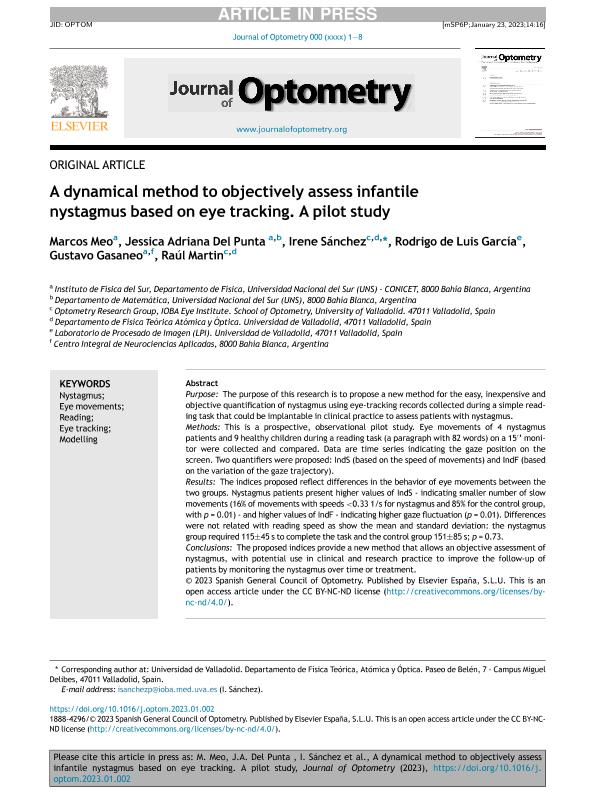Artículo
A dynamical method to objectively assess infantile nystagmus based on eye tracking. A pilot study
Meo, Marcos Miguel ; del Punta, Jessica Adriana
; del Punta, Jessica Adriana ; Sánchez Pavón, Irene; de Luis García, Rodrigo; Gasaneo, Gustavo
; Sánchez Pavón, Irene; de Luis García, Rodrigo; Gasaneo, Gustavo ; Martin, Raúl
; Martin, Raúl
 ; del Punta, Jessica Adriana
; del Punta, Jessica Adriana ; Sánchez Pavón, Irene; de Luis García, Rodrigo; Gasaneo, Gustavo
; Sánchez Pavón, Irene; de Luis García, Rodrigo; Gasaneo, Gustavo ; Martin, Raúl
; Martin, Raúl
Fecha de publicación:
01/2023
Editorial:
Spanish Council of Optometry
Revista:
Journal of Optometry
ISSN:
1888-4296
e-ISSN:
1989-1342
Idioma:
Inglés
Tipo de recurso:
Artículo publicado
Clasificación temática:
Resumen
Purpose: The purpose of this research is to propose a new method for the easy, inexpensive and objective quantification of nystagmus using eye-tracking records collected during a simple reading task that could be implantable in clinical practice to assess patients with nystagmus. Methods: This is a prospective, observational pilot study. Eye movements of 4 nystagmus patients and 9 healthy children during a reading task (a paragraph with 82 words) on a 15′’ monitor were collected and compared. Data are time series indicating the gaze position on the screen. Two quantifiers were proposed: IndS (based on the speed of movements) and IndF (based on the variation of the gaze trajectory). Results: The indices proposed reflect differences in the behavior of eye movements between the two groups. Nystagmus patients present higher values of IndS - indicating smaller number of slow movements (16% of movements with speeds <0.33 1/s for nystagmus and 85% for the control group, with p = 0.01) - and higher values of IndF - indicating higher gaze fluctuation (p = 0.01). Differences were not related with reading speed as show the mean and standard deviation: the nystagmus group required 115±45 s to complete the task and the control group 151±85 s; p = 0.73. Conclusions: The proposed indices provide a new method that allows an objective assessment of nystagmus, with potential use in clinical and research practice to improve the follow-up of patients by monitoring the nystagmus over time or treatment.
Palabras clave:
EYE MOVEMENTS
,
EYE TRACKING
,
MODELLING
,
NYSTAGMUS
,
READING
Archivos asociados
Licencia
Identificadores
Colecciones
Articulos(IFISUR)
Articulos de INSTITUTO DE FISICA DEL SUR
Articulos de INSTITUTO DE FISICA DEL SUR
Citación
Meo, Marcos Miguel; del Punta, Jessica Adriana; Sánchez Pavón, Irene; de Luis García, Rodrigo; Gasaneo, Gustavo; et al.; A dynamical method to objectively assess infantile nystagmus based on eye tracking. A pilot study; Spanish Council of Optometry; Journal of Optometry; 16; 3; 1-2023; 221-228
Compartir
Altmétricas



